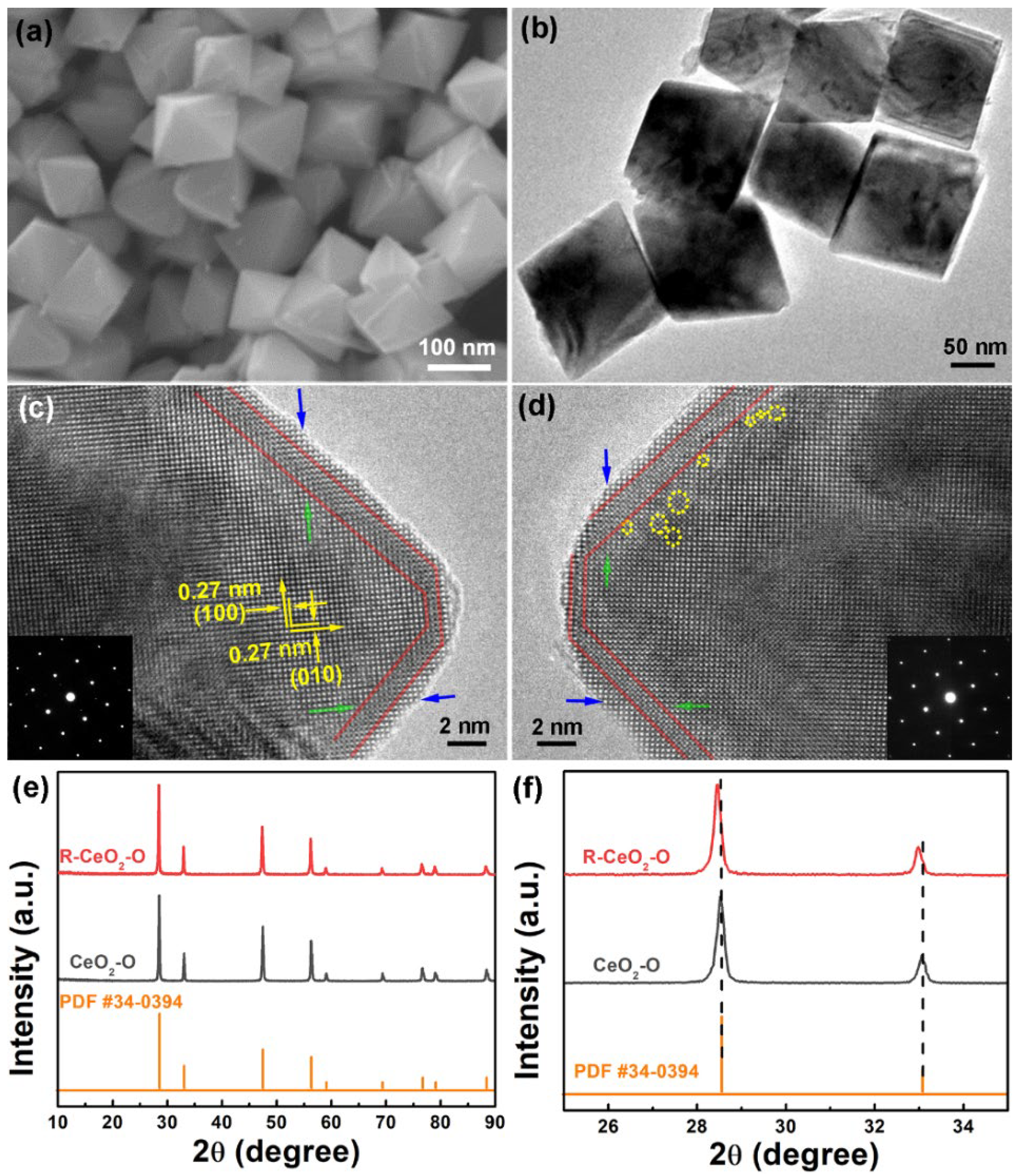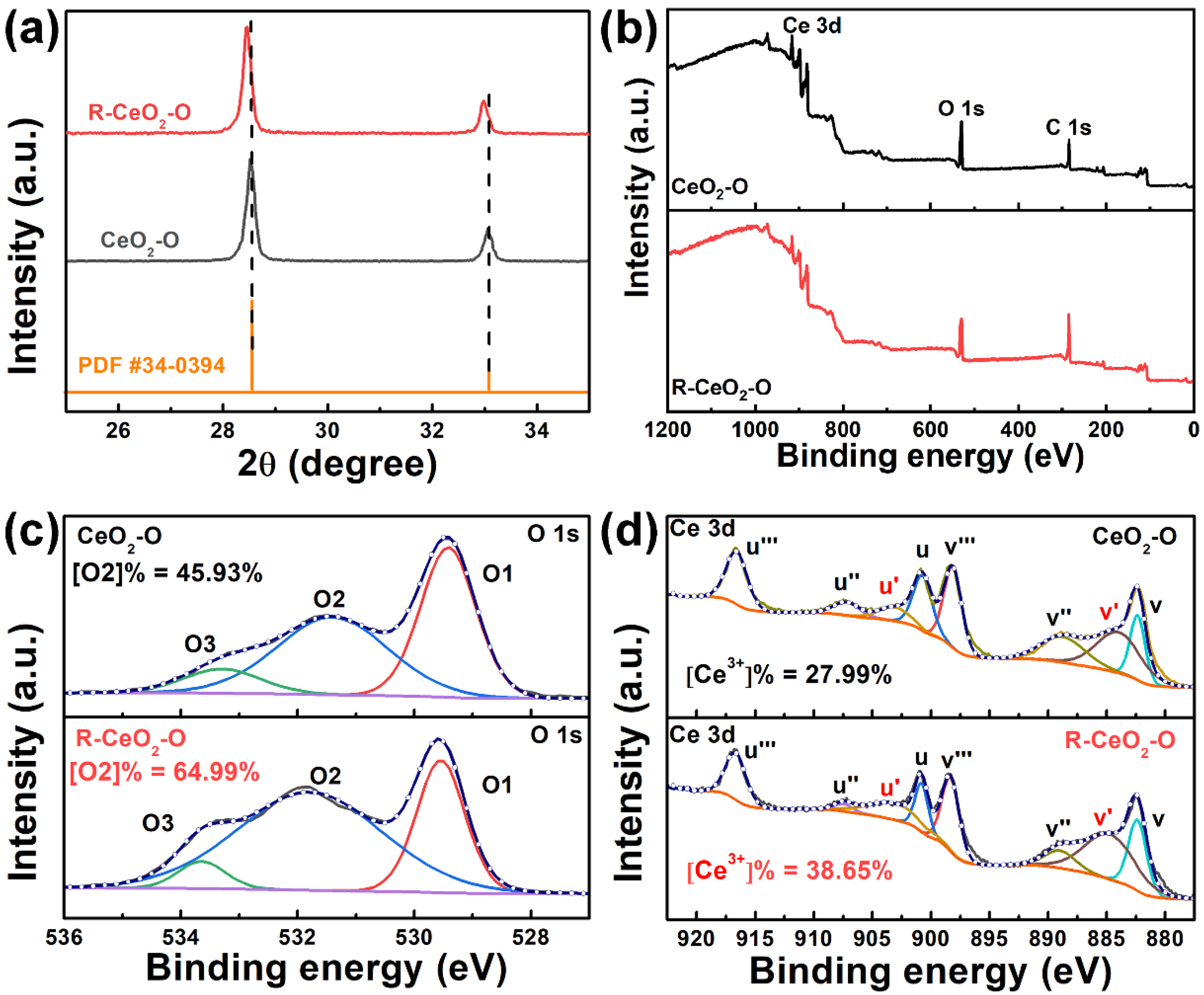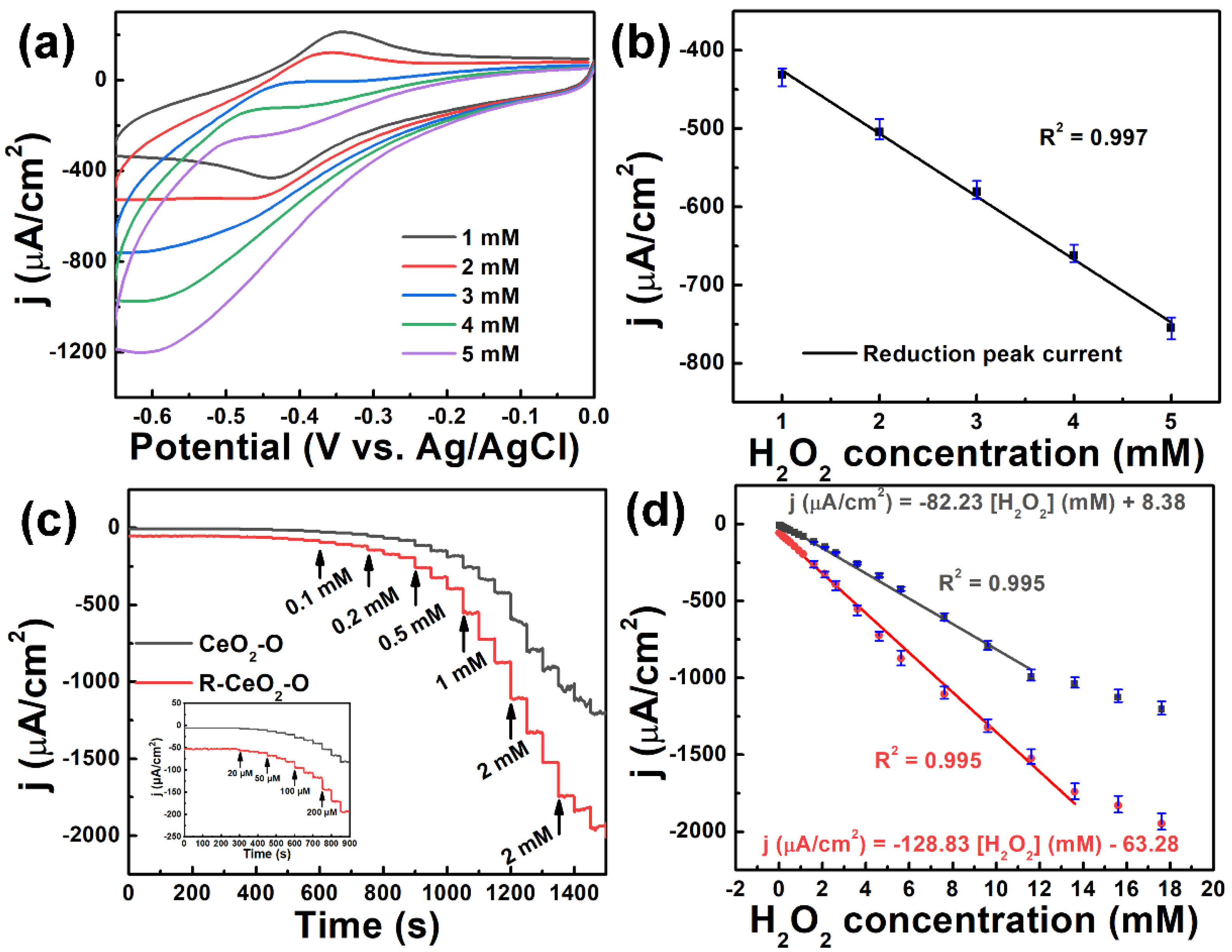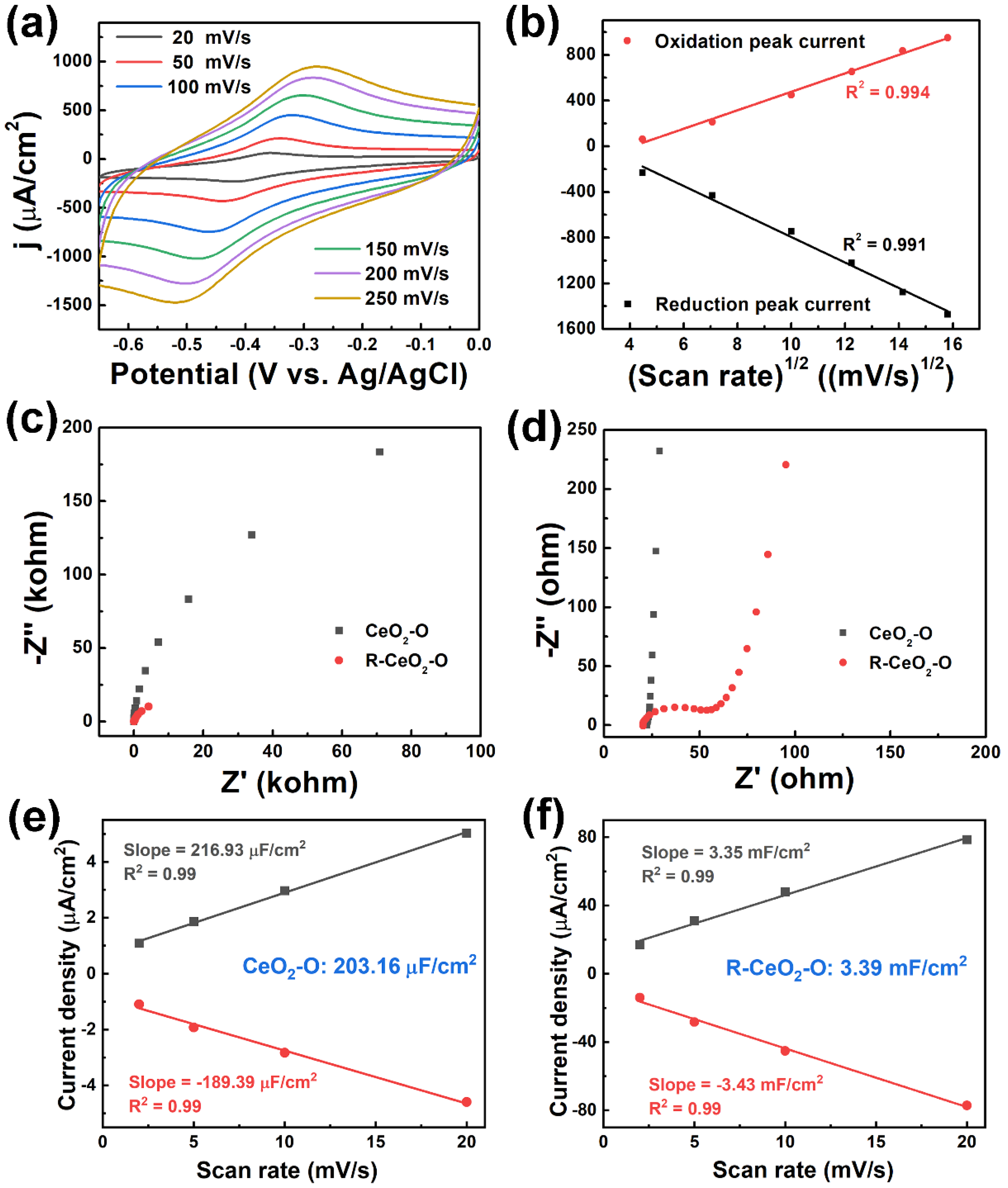Oxygen Vacancy Injection on (111) CeO2 Nanocrystal Facets for Efficient H2O2 Detection
Abstract
:1. Introduction
2. Materials and Methods
2.1. Reagents and Apparatus
2.2. Preparation of CeO2 with Selectively Exposed Facet
2.2.1. Preparation of CeO2 with Selectively Exposed Facet
2.2.2. Non-Contacting Reduction Process of CeO2
2.2.3. Preparation of Electrode
2.3. Electrochemical Measurements
3. Results and Discussion
3.1. Characterization of OVs in CeO2-O
3.2. Effect of OVs on H2O2 Sensing Performance
3.3. Synergistic Effect of Facets and Oxygen Vacancies
3.4. Mechanism of Boosted Sensing Performance on R-CeO2-O
3.5. Investigation of Selectivity, Stability, Reproducibility and Practicability
4. Conclusions
Supplementary Materials
Author Contributions
Funding
Institutional Review Board Statement
Informed Consent Statement
Data Availability Statement
Conflicts of Interest
References
- Yang, N.; Xiao, W.; Song, X.; Wang, W.; Dong, X. Recent Advances in Tumor Microenvironment Hydrogen Peroxide-Responsive Materials for Cancer Photodynamic Therapy. Nano-Micro Lett. 2020, 12, 15. [Google Scholar] [CrossRef] [PubMed] [Green Version]
- Yabuta, K.; Futamura, H.; Kawasaki, K.; Sugiyama, H. Impact of H2O2 Sorption by Polymers on the Duration of Aeration in Pharmaceutical Decontamination. J. Pharm. Sci. 2020, 109, 2767–2773. [Google Scholar] [CrossRef] [PubMed]
- Collivignarelli, M.C.; Abbà, A.; Miino, M.C.; Arab, H.; Bestetti, M.; Franz, S. Decolorization and biodegradability of a real pharmaceutical wastewater treated by H2O2-assisted photoelectrocatalysis on TiO2 meshes. J. Hazard. Mater. 2019, 387, 121668. [Google Scholar] [CrossRef] [PubMed]
- Zlatev, R.; Ramos, R.; Stoytcheva, M.; Valdez, B.; Curiel, M. LabView based virtual calorimetric etching solution analyzer (CESA) for the online quantification of hydrogen peroxide for the semiconductor industry. Instrum. Sci. Technol. 2021, 50, 397–413. [Google Scholar] [CrossRef]
- Rajput, V.D.; Singh, R.K.; Verma, K.K.; Sharma, L.; Quiroz-Figueroa, F.R.; Meena, M.; Gour, V.S.; Minkina, T.; Sushkova, S.; Mandzhieva, S. Recent Developments in Enzymatic Antioxidant Defence Mechanism in Plants with Special Reference to Abiotic Stress. Biology 2021, 10, 267. [Google Scholar] [CrossRef] [PubMed]
- Zhang, Y.; Wang, Q.; Liu, D.; Wang, Q.; Li, T.; Wang, Z. Cu2O-BiOI isotype (p-p) heterojunction: Boosted visible-light-driven photoelectrochemical activity for non-enzymatic H2O2 sensing. Appl. Surf. Sci. 2020, 521, 146434. [Google Scholar] [CrossRef]
- Wang, Q.; Wang, Q.; Li, M.; Szunerits, S.; Boukherroub, R. One-step synthesis of Au nanoparticle–graphene composites using tyrosine: Electrocatalytic and catalytic properties. New J. Chem. 2016, 40, 5473–5482. [Google Scholar] [CrossRef]
- Yang, H.; Zhou, C.; An, J.; Yang, L.; Yang, Y.; Liu, X. Ultra-fast synthesis of iron decorated multiwalled carbon nanotube composite materials: A sensitive electrochemical sensor for determining dopamine. J. Alloy. Compd. 2021, 897, 163257. [Google Scholar] [CrossRef]
- Imran, H.; Vaishali, K.; Francy, S.A.; Manikandan, P.N.; Dharuman, V. Platinum and zinc oxide modified carbon nitride electrode as non-enzymatic highly selective and reusable electrochemical diabetic sensor in human blood. Bioelectrochemistry 2020, 137, 107645. [Google Scholar] [CrossRef] [PubMed]
- Jin, X.; Duan, Y.; Liu, D.; Feng, X.; Li, W.; Zhang, Z.; Zhang, Y. CO Oxidation Catalyzed by Two-Dimensional Co3O4/CeO2 Nanosheets. ACS Appl. Nano Mater. 2019, 2, 5769–5778. [Google Scholar] [CrossRef]
- Wen, X.-J.; Niu, C.-G.; Zhang, L.; Liang, C.; Zeng, G.-M. A novel Ag2O/CeO2 heterojunction photocatalysts for photocatalytic degradation of enrofloxacin: Possible degradation pathways, mineralization activity and an in depth mechanism insight. Appl. Catal. B Environ. 2017, 221, 701–714. [Google Scholar] [CrossRef]
- Sun, H.; Tian, C.; Fan, G.; Qi, J.; Liu, Z.; Yan, Z.; Cheng, F.; Chen, J.; Li, C.; Du, M. Boosting Activity on Co4N Porous Nanosheet by Coupling CeO2 for Efficient Electrochemical Overall Water Splitting at High Current Densities. Adv. Funct. Mater. 2020, 30, 1910596. [Google Scholar] [CrossRef]
- Yuan, K.; Wang, C.-Y.; Zhu, L.-Y.; Cao, Q.; Yang, J.-H.; Li, X.-X.; Huang, W.; Wang, Y.-Y.; Lu, H.-L.; Zhang, D.W. Fabrication of a Micro-Electromechanical System-Based Acetone Gas Sensor Using CeO2 Nanodot-Decorated WO3 Nanowires. ACS Appl. Mater. Interfaces 2020, 12, 14095–14104. [Google Scholar] [CrossRef] [PubMed]
- Gao, Y.; Wu, Q.; Liang, X.; Wang, Z.; Zheng, Z.; Wang, P.; Liu, Y.; Dai, Y.; Whangbo, M.; Huang, B. Cu2O Nanoparticles with Both {100} and {111} Facets for Enhancing the Selectivity and Activity of CO2 Electroreduction to Ethylene. Adv. Sci. 2020, 7, 1902820. [Google Scholar] [CrossRef] [PubMed] [Green Version]
- Ni, C.; Li, Y.; Meng, X.; Liu, S.; Luo, S.; Guan, J.; Jiang, B. Synergistic role of electron-trapped oxygen vacancy and exposed TiO2 [0 0 1] facets toward electrochemical p-nitrophenol reduction: Characterization, performance and mechanism. Chem. Eng. J. 2021, 411, 128485. [Google Scholar] [CrossRef]
- Chen, S.; Huang, D.; Zeng, G.; Xue, W.; Lei, L.; Xu, P.; Deng, R.; Li, J.; Cheng, M. In-situ synthesis of facet-dependent BiVO4/Ag3PO4/PANI photocatalyst with enhanced visible-light-induced photocatalytic degradation performance: Synergism of interfacial coupling and hole-transfer. Chem. Eng. J. 2019, 382, 122840. [Google Scholar] [CrossRef]
- Zhu, K.; Shi, F.; Zhu, X.; Yang, W. The roles of oxygen vacancies in electrocatalytic oxygen evolution reaction. Nano Energy 2020, 73, 104761. [Google Scholar] [CrossRef]
- Gunkel, F.; Christensen, D.V.; Chen, Y.Z.; Pryds, N. Oxygen vacancies: The (in)visible friend of oxide electronics. Appl. Phys. Lett. 2020, 116, 120505. [Google Scholar] [CrossRef] [Green Version]
- Al-Hashem, M.; Akbar, S.; Morris, P. Role of Oxygen Vacancies in Nanostructured Metal-Oxide Gas Sensors: A Review. Sens. Actuators B Chem. 2019, 301, 126845. [Google Scholar] [CrossRef]
- Spezzati, G.; Benavidez, A.D.; DeLaRiva, A.T.; Su, Y.; Hofmann, J.P.; Asahina, S.; Olivier, E.J.; Neethling, J.H.; Miller, J.T.; Datye, A.K.; et al. CO oxidation by Pd supported on CeO2(100) and CeO2(111) facets. Appl. Catal. B Environ. 2018, 243, 36–46. [Google Scholar] [CrossRef]
- Wang, M.; Shen, M.; Jin, X.; Tian, J.; Li, M.; Zhou, Y.; Zhang, L.; Li, Y.; Shi, J. Oxygen Vacancy Generation and Stabilization in CeO2–x by Cu Introduction with Improved CO2 Photocatalytic Reduction Activity. ACS Catal. 2019, 9, 4573–4581. [Google Scholar] [CrossRef]
- Zheng, X.; Li, Y.; Zhang, L.; Shen, L.; Xiao, Y.; Zhang, Y.; Au, C.; Jiang, L. Insight into the effect of morphology on catalytic performance of porous CeO2 nanocrystals for H2S selective oxidation. Appl. Catal. B Environ. 2019, 252, 98–110. [Google Scholar] [CrossRef]
- Wang, Z.; Huang, Z.; Brosnahan, J.T.; Zhang, S.; Guo, Y.; Guo, Y.; Wang, L.; Wang, Y.; Zhan, W. Ru/CeO2 Catalyst with Optimized CeO2 Support Morphology and Surface Facets for Propane Combustion. Environ. Sci. Technol. 2019, 53, 5349–5358. [Google Scholar] [CrossRef]
- Su, Z.; Yang, W.; Wang, C.; Xiong, S.; Cao, X.; Peng, Y.; Si, W.; Weng, Y.; Xue, M.; Li, J. Roles of Oxygen Vacancies in the Bulk and Surface of CeO2 for Toluene Catalytic Combustion. Environ. Sci. Technol. 2020, 54, 12684–12692. [Google Scholar] [CrossRef]
- Esch, F.; Fabris, S.; Zhou, L.; Montini, T.; Africh, C.; Fornasiero, P.; Comelli, G.; Rosei, R. Electron Localization Determines Defect Formation on Ceria Substrates. Science 2005, 309, 752–755. [Google Scholar] [CrossRef] [PubMed]
- Liu, X.; Zhou, K.; Wang, L.; Wang, B.; Li, Y. Oxygen Vacancy Clusters Promoting Reducibility and Activity of Ceria Nanorods. J. Am. Chem. Soc. 2009, 131, 3140–3141. [Google Scholar] [CrossRef] [PubMed]
- Han, X.; Amrane, N.; Zhang, Z.; Benkraouda, M. Unraveling the Negative Role of Oxygen-Vacancy Cluster in Ionic Conductivity in CeO2: Hybrid Functional Study. J. Phys. Chem. C 2018, 122, 5871–5880. [Google Scholar] [CrossRef]
- Namai, Y.; Fukui, K.-I.; Iwasawa, Y. Atom-Resolved Noncontact Atomic Force Microscopic Observations of CeO2 (111) Surfaces with Different Oxidation States: Surface Structure and Behavior of Surface Oxygen Atoms. J. Phys. Chem. B 2003, 107, 11666–11673. [Google Scholar] [CrossRef]
- Torbrügge, S.; Reichling, M.; Ishiyama, A.; Morita, S.; Custance, O. Evidence of Subsurface Oxygen Vacancy Ordering on Reduced CeO2 (111). Phys. Rev. Lett. 2007, 99, 056101. [Google Scholar] [CrossRef] [PubMed] [Green Version]
- Wang, Z.; Yang, C.; Lin, T.; Yin, H.; Chen, P.; Wan, D.; Xu, F.; Huang, F.; Lin, J.; Xie, X.; et al. Visible-light photocatalytic, solar thermal and photoelectrochemical properties of aluminium-reduced black titania. Energy Environ. Sci. 2013, 6, 3007–3014. [Google Scholar] [CrossRef]
- Ribicki, A.C.; Chemin, B.G.; Van Haandel, V.J.; Winiarski, J.P.; Rozada, T.D.C.; Pessoa, C.A.; Estrada, R.A.; Fiorin, B.C.; Fujiwara, S.T. Sol gel synthesis of 3-n-propyl(4-aminomethyl)pyridinium silsesquioxane chloride and the enhanced electrocatalytic activity of LbL films. J. Sol-Gel Sci. Technol. 2018, 87, 216–229. [Google Scholar] [CrossRef]
- Calaça, G.N.; Erdmann, C.A.; Soares, A.L.; Pessôa, C.A.; Fujiwara, S.T.; Garcia, J.R.; Vidotti, M.; Wohnrath, K. Layer-by-Layer AuNPs-SiPy+/Prussian blue nanoparticles modified electrodes: Characterization and electrocatalytic effects. Electrochim. Acta 2017, 249, 104–112. [Google Scholar] [CrossRef]
- de Jesus, C.G.; Lima, D.; dos Santos, V.; Wohnrath, K.; Pessôa, C.A. Glucose biosensor based on the highly efficient immobilization of glucose oxidase on layer-by-layer films of silsesquioxane polyelectrolyte. Sens. Actuators B Chem. 2013, 186, 44–51. [Google Scholar] [CrossRef]
- Wang, Z.; Yang, C.; Lin, T.; Yin, H.; Chen, P.; Wan, D.; Xu, F.; Huang, F.; Lin, J.; Xie, X.; et al. H-Doped Black Titania with Very High Solar Absorption and Excellent Photocatalysis Enhanced by Localized Surface Plasmon Resonance. Adv. Funct. Mater. 2013, 23, 5444–5450. [Google Scholar] [CrossRef]
- Shyu, J.Z.; Weber, W.H.; Gandhi, H.S. Surface characterization of alumina-supported ceria. J. Phys. Chem. 1988, 92, 4964–4970. [Google Scholar] [CrossRef]
- Tan, H.; Wang, J.; Yu, S.; Zhou, K. Support Morphology-Dependent Catalytic Activity of Pd/CeO2 for Formaldehyde Oxidation. Environ. Sci. Technol. 2015, 49, 8675–8682. [Google Scholar] [CrossRef]
- Kosacki, I.; Suzuki, T.; Anderson, H.U.; Colomban, P. Raman scattering and lattice defects in nanocrystalline CeO2 thin films. Solid State Ion. 2002, 149, 99–105. [Google Scholar] [CrossRef]
- Uzunoglu, A.; Ipekci, H.H. The use of CeO2-modified Pt/C catalyst inks for the construction of high-performance enzyme-free H2O2 sensors. J. Electroanal. Chem. 2019, 848, 113302. [Google Scholar] [CrossRef]
- Spanier, J.E.; Robinson, R.D.; Zhang, F.; Chan, S.-W.; Herman, I.P. Size-dependent properties of CeO2−ynanoparticles as studied by Raman scattering. Phys. Rev. B 2001, 64, 245407. [Google Scholar] [CrossRef] [Green Version]
- Taniguchi, T.; Watanabe, T.; Sugiyama, N.; Subramani, A.K.; Wagata, H.; Matsushita, N.; Yoshimura, M. Identifying Defects in Ceria-Based Nanocrystals by UV Resonance Raman Spectroscopy. J. Phys. Chem. C 2009, 113, 19789–19793. [Google Scholar] [CrossRef]
- Lu, J.; Wang, J.; Zou, Q.; He, D.; Zhang, L.; Xu, Z.; He, S.; Luo, Y. Unravelling the Nature of the Active Species as well as the Doping Effect over Cu/Ce-Based Catalyst for Carbon Monoxide Preferential Oxidation. ACS Catal. 2019, 9, 2177–2195. [Google Scholar] [CrossRef]
- Mehmood, R.; Mofarah, S.S.; Chen, W.-F.; Koshy, P.; Sorrell, C.C. Surface, Subsurface, and Bulk Oxygen Vacancies Quantified by Decoupling and Deconvolution of the Defect Structure of Redox-Active Nanoceria. Inorg. Chem. 2019, 58, 6016–6027. [Google Scholar] [CrossRef] [PubMed]
- Wang, L.; Yu, Y.; He, H.; Zhang, Y.; Qin, X.-B.; Wang, B. Oxygen vacancy clusters essential for the catalytic activity of CeO2 nanocubes for o-xylene oxidation. Sci. Rep. 2017, 7, 12845. [Google Scholar] [CrossRef]
- Zhidkov, I.S.; Maksimov, R.N.; Kukharenko, A.I.; Finkelstein, L.D.; Cholakh, S.O.; Osipov, V.V.; Kurmaev, E.Z. Effect of post-annealing in air on optical and XPS spectra of Y2O3 ceramics doped with CeO2. Mendeleev Commun. 2019, 29, 102–104. [Google Scholar] [CrossRef]
- Qiu, B.; Wang, C.; Zhang, N.; Cai, L.; Xiong, Y.; Chai, Y. CeO2-Induced Interfacial Co2+ Octahedral Sites and Oxygen Vacancies for Water Oxidation. ACS Catal. 2019, 9, 6484–6490. [Google Scholar] [CrossRef]
- He, W.; Ran, J.; Niu, J.; Yang, G.; Ou, Z.; He, Z. Insight into the effect of facet-dependent surface and oxygen vacancies of CeO2 for Hg removal: From theoretical and experimental studies. J. Hazard. Mater. 2020, 397, 122646. [Google Scholar] [CrossRef]
- Uzunoglu, A. The Use of CeO2-TiO2 Nanocomposites as Enzyme Immobilization Platforms in Electrochemical Sensors. J. Turk. Chem. Soc. Sect. A Chem. 2017, 4, 855–868. [Google Scholar] [CrossRef] [Green Version]
- Jha, S.K.; Kumar, C.N.; Raj, R.P.; Jha, N.S.; Mohan, S. Synthesis of 3D porous CeO2/reduced graphene oxide xerogel composite and low level detection of H2O2. Electrochim. Acta 2014, 120, 308–313. [Google Scholar] [CrossRef] [Green Version]
- Zhao, S.; Riedel, M.; Patarroyo, J.; Bastús, N.G.; Puntes, V.; Yue, Z.; Lisdat, F.; Parak, W.J. Introducing visible-light sensitivity into photocatalytic CeO2 nanoparticles by hybrid particle preparation exploiting plasmonic properties of gold: Enhanced photoelectrocatalysis exemplified for hydrogen peroxide sensing. Nanoscale 2020, 13, 980–990. [Google Scholar] [CrossRef] [PubMed]
- Ujjain, S.K.; Das, A.; Srivastava, G.; Ahuja, P.; Roy, M.; Arya, A.; Bhargava, K.; Sethy, N.; Singh, S.K.; Sharma, R.K.; et al. Nanoceria based electrochemical sensor for hydrogen peroxide detection. Biointerphases 2014, 9, 031011. [Google Scholar] [CrossRef] [PubMed]
- Ampelli, C.; Leonardi, S.G.; Bonavita, A.; Genovese, C.; Papanikolaou, G.; Perathoner, S.; Centi, G.; Neri, G. Electrochemical H2O2 sensors based on Au/CeO2 nanoparticles for industrial applications. Chem. Eng. Trans. 2015, 43, 733–738. [Google Scholar] [CrossRef]
- Yang, X.; Ouyang, Y.; Wu, F.; Hu, Y.; Ji, Y.; Wu, Z. Size controllable preparation of gold nanoparticles loading on graphene sheets@cerium oxide nanocomposites modified gold electrode for nonenzymatic hydrogen peroxide detection. Sens. Actuators B Chem. 2017, 238, 40–47. [Google Scholar] [CrossRef]
- Yang, S.; Li, G.; Wang, G.; Liu, L.; Wang, D.; Qu, L. Synthesis of highly dispersed CeO2 nanoparticles on N-doped reduced oxide graphene and their electrocatalytic activity toward H2O2. J. Alloy. Compd. 2016, 688, 910–916. [Google Scholar] [CrossRef]
- Chen, J.; Zhao, W.; Wu, Q.; Mi, J.; Wang, X.; Ma, L.; Jiang, L.; Au, C.; Li, J. Effects of anaerobic SO2 treatment on nano-CeO2 of different morphologies for selective catalytic reduction of NOx with NH3. Chem. Eng. J. 2019, 382, 122910. [Google Scholar] [CrossRef]
- Jiang, F.; Wang, S.; Liu, B.; Liu, J.; Wang, L.; Xiao, Y.; Xu, Y.; Liu, X. Insights into the Influence of CeO2 Crystal Facet on CO2 Hydrogenation to Methanol over Pd/CeO2 Catalysts. ACS Catal. 2020, 10, 11493–11509. [Google Scholar] [CrossRef]
- Tong, T.; Liu, X.; Guo, Y.; Banis, M.N.; Hu, Y.; Wang, Y. The critical role of CeO2 crystal-plane in controlling Pt chemical states on the hydrogenolysis of furfuryl alcohol to 1,2-pentanediol. J. Catal. 2018, 365, 420–428. [Google Scholar] [CrossRef]
- Trabelsi, H.; Bejar, M.; Dhahri, E.; Sajieddine, M.; Khirouni, K.; Prezas, P.; Melo, B.; Valente, M.; Graca, M.P. Effect of oxygen vacancies on SrTiO electrical properties. J. Alloy. Compd. 2017, 723, 894–903. [Google Scholar] [CrossRef]
- Paier, J.; Penschke, C.; Sauer, J. Oxygen Defects and Surface Chemistry of Ceria: Quantum Chemical Studies Compared to Experiment. Chem. Rev. 2013, 113, 3949–3985. [Google Scholar] [CrossRef] [PubMed]
- Trovarelli, A.; Llorca, J. Ceria Catalysts at Nanoscale: How Do Crystal Shapes Shape Catalysis? ACS Catal. 2017, 7, 4716–4735. [Google Scholar] [CrossRef]
- Nolan, M.; Parker, S.C.; Watson, G.W. The electronic structure of oxygen vacancy defects at the low index surfaces of ceria. Surf. Sci. 2005, 595, 223–232. [Google Scholar] [CrossRef]
- Wu, T.; Vegge, T.; Hansen, H.A. Improved Electrocatalytic Water Splitting Reaction on CeO2 (111) by Strain Engineering: A DFT+U Study. ACS Catal. 2019, 9, 4853–4861. [Google Scholar] [CrossRef]
- Wu, T.; López, N.; Vegge, T.; Hansen, H.A. Facet-dependent electrocatalytic water splitting reaction on CeO2: A DFT + U study. J. Catal. 2020, 388, 1–10. [Google Scholar] [CrossRef]
- Gao, Y.; Li, R.; Chen, S.; Luo, L.; Cao, T.; Huang, W. Morphology-dependent interplay of reduction behaviors, oxygen vacancies and hydroxyl reactivity of CeO2 nanocrystals. Phys. Chem. Chem. Phys. 2015, 17, 31862–31871. [Google Scholar] [CrossRef] [PubMed]
- Ensafi, A.A.; Mahmoodi, A.; Rezaei, B. Pd@CeO2-SnO2 nanocomposite, a highly selective and sensitive hydrogen peroxide electrochemical sensor. Sens. Actuators B Chem. 2019, 296, 126683. [Google Scholar] [CrossRef]







| Sensitivity (μA mM−1 cm−2) | Linear Range (μM) | Detection Limit (μM) | References | |
|---|---|---|---|---|
| R-CeO2-O | 128.83 | 20–13,610 | 1.63 | This work |
| CeO2-O | 82.23 | 20–11,610 | 2.45 | This work |
| 1 CeO2/GC | - | 91.88–2000 | 31.29 | [48] |
| 2 CeO2 NPs | 0.126 | 50–1000 | 27 | [49] |
| 3 CeO2-HMTA | 21.13 | 1–1000 | 0.6 | [50] |
| 1000–25,000 | ||||
| CeO2-fructose | 9.6 | 10–1000 | 2 | [50] |
| 1000–25,000 | ||||
| Au/CeO2 NPs | 1.150 | 4–2000 | 3 | [49] |
| Au/CeO2 | 27.1 | 0–30 | 5 | [51] |
| Pt/C-CeO2 | 185.4 | 10–3000 | 2 | [52] |
| 4 GS@CeO2/Au on GE | 94.42 | 1–10,000 | 0.26 | [38] |
| 5 CeO2 NP/N-rGO | 5.092 | 1.8–920.8 | 1.3 | [53] |
| Added (μM) | Detected (μM) | RSD (%, n = 3) | Recovery (%) |
|---|---|---|---|
| 80 | 81.560 | 2.83 | 101.95 |
| 160 | 157.08 | 1.73 | 98.160 |
| 300 | 301.96 | 2.20 | 100.65 |
Publisher’s Note: MDPI stays neutral with regard to jurisdictional claims in published maps and institutional affiliations. |
© 2022 by the authors. Licensee MDPI, Basel, Switzerland. This article is an open access article distributed under the terms and conditions of the Creative Commons Attribution (CC BY) license (https://creativecommons.org/licenses/by/4.0/).
Share and Cite
Li, T.; Wang, Q.; Wang, Z. Oxygen Vacancy Injection on (111) CeO2 Nanocrystal Facets for Efficient H2O2 Detection. Biosensors 2022, 12, 592. https://doi.org/10.3390/bios12080592
Li T, Wang Q, Wang Z. Oxygen Vacancy Injection on (111) CeO2 Nanocrystal Facets for Efficient H2O2 Detection. Biosensors. 2022; 12(8):592. https://doi.org/10.3390/bios12080592
Chicago/Turabian StyleLi, Tong, Qi Wang, and Zhou Wang. 2022. "Oxygen Vacancy Injection on (111) CeO2 Nanocrystal Facets for Efficient H2O2 Detection" Biosensors 12, no. 8: 592. https://doi.org/10.3390/bios12080592






